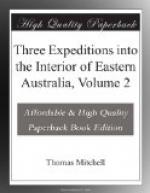Having buried on the left bank another letter of instructions for Mr. Stapylton according to certain marks as previously arranged with him, we mounted our boat on the carriage (which had been brought across early in the morning) and continued our journey. I expected to find a ford in this river but, considering the swollen state in which it then was, I instructed Mr. Stapylton to remain encamped on the left bank until the boat should return from the Murray, as beyond that river we were not likely to have further occasion for it. Our way on leaving the Bayunga was rather intricate, being amongst lagoons left by high floods of the river. Some of them were fine sheets of water, apparently much frequented by ducks and other aquatic birds.
LEVEL FOREST COUNTRY.
At exactly 2 1/2 miles from the river we reached the outer bank or berg, and resumed at length the straight course homewards, for I there found a level forest country open before me, through which we travelled about eight miles in a south-east direction. We then encamped near some waterholes which I found on our right, in the surface of a clay soil and close to a plain extending southward. The wood throughout the forest consisted of the box or goborro species of eucalyptus and we crossed, soon after first entering it, a small plain. At 3 1/2 miles from the last camp on this line, the low alluvial bed of the river with a deep lagoon in it as broad as the river itself appeared close to us on the left; and as I had seen some indications of the Bayunga on the other side also, or to our right, it was obvious that we had just met with this river at one of its most western bends, an object I had in view in following down the Deegay from the westward. The forest country traversed by the party this day was in general grassy and good and, as it was open enough to afford a prospect of about a mile around us, we travelled on in a straight line with unwonted ease and facility.
October 10.
We continued our journey homeward through a country of the same character as that seen yesterday, at least for the first five miles, when we came at length to a chain of deep ponds, the second we had encountered that morning. In the bank of this I found a stratum of alluvium; but beyond it the soil was granitic, and banksia was seen there for the first time after crossing the river. At 7 1/4 miles we met with another chain of large ponds, and at 9 miles a running stream flowing to the north-west. After passing over various other chains of ponds we encamped at the end of 14 1/2 miles near the bank of a running stream in which were also some deep pools and which, from some flowers growing there, were named by the men Violet Ponds.
October 11.




